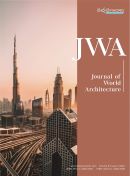Analysis and Research on the Thermal Environment of Subway Stations in Wuhan
Abstract
With the rapid advancement of urban construction, urban subway construction in China has entered an advanced development stage and the thermal environment of subway stations has become a key factor affecting passengers' thermal comfort. To further understand the actual situation of the thermal environment of subway stations, field measurement and CFD simulation were carried out on a subway station hall in Wuhan from July to August 2021, and the thermal environment changes and influencing factors during subway operation were compared and analyzed. The present situation of the thermal environment in subway stations was analyzed, and some suggestions and measures for improving the thermal environment were put forward.
References
Wallace L, 1996, Indoor Particles, A Review. Journal of the Air and Waste Management Association, 46(2): 98–126.
Cai X, Yang D, Ran S, 2019, Study on the Influence of Rail Transit on Urban Spatial Development-Taking Zhengzhou Subway as an Example. Chinese and Foreign Architecture, 2019(04): 119-122.
Li G, 2011, Present Situation and Development Trend of Ventilation and Air Conditioning System in Urban Rail Transit. HVAC, 4(6): 1–6.
Ministry of Housing and Urban-Rural Development of the People’s Republic of China, 2013, Code for Metro Design, GB50157-2013, China Building Industry Press, viewed July 20, 2021.
Yu X, Zhang W, 2019, Zhengzhou Urban Space Development History and the Impact of Subway Construction on It. Chinese and Foreign Architecture, 2019(03): 97–100.
Ke M-T, Cheng T-C, Wang W-P, 2002, Numerical Simulation for Optimizing the Design of Subway Environmental Control System. Building And Environment, 37(8): 1139–1152.
Corgnati SP, Ansaldi R, Filippi M, 2009, Thermal Comfort in Italian Classrooms Under Free Running. Conditions During Mid Seasons: Assessment Through Objective and Subjective Approaches. Building and Environment, 44(4): 785–792.
Jung GJ, Song SK, Ahn YC, et al., 2011, Experimental Research on Thermal Comfort in the University Classroom of Regular Semesters in Korea. Journal of Mechanical Science and Technology, 25(2): 503–512.
Li B, Liu J, Yao R, 2007, Investigation and Analysis of Classroom Thermal Environment in Chongqing in Winter. HVAC, 37(5): 115–117.
Hu TL, Cao B, Zhu YX, et al., 2015, Influence of Usage Rate of Self-Study Classrooms on Indoor Thermal Environment During Heating Season in Beijing Universities. HVAC, 45(08): 98–101.
Wang Z, Li A, Ren J, et al., 2014, Thermal Adaptation and Thermal Environment in University Classrooms and Offices in Harbin. Energy and Buildings, 2014(77): 192–196.
Li A, 2012, Field Study on Thermal Comfort and Thermal Adaptation of University Buildings in Cold Region, dissertation, Harbin Institute of Technology.
Djamila H, Chu CM, Kumaresan S, 2014, Effect of Humidity on Thermal Comfort in the Humidtropics[J]. Journal of Building Construction and Planning Research, 02(2): 109–117.
Oliveira C, Rupp RF, Ghisi E, 2021, Influence of Environmental Variables on Thermal Comfort and Air Quality Perception in Office Buildings in the Humid Subtropical Climate Zone of Brazil. Energy and buildings, 2021: 110982.
He S, Jin L, Wu X, et al., 2017, Measurement of Respirable Particulate Matter in Typical Subway System in Beijing. Safety and Environmental Engineering, 24(01): 40–44.
Mugica-Alvarez V, Figueroa-Lara J, Romeroromo M, et al., 2012, Concentrations and Properties of Airborne Particles in the Mexico City Subway System. Atmospheric Environment, 49: 284–293.
Cheng Y-H, Lin Y-L, 2010, Measurement of Particle Mass Concentrations and Size Distributions in an Underground Station. Aerosol and Air Quality Research, 10(1): 22–29.
Aarnio P, Yli-Tuomi T, Kousa A, et al., 2005, The Concentrations and Composition of and Exposure to Fine Particles (PM2.5) in the Helsinki Subway System. Atmospheric Environment, 39(28): 5059–5066.
Wang S-G, Zhu Y-X, Jiang Y, 1997, Measurement and Analysis of Wall Heat Flux in Thermal Environment of Beijing Subway. Underground Engineering and Tunnel, 1997(3): 32–37.
Wang L, Wu X, Song J, et al., 2010, Study on the Characteristics of Velocity Field and Temperature Field in Subway Tunnel. Acta Refrigeration Sinica, 31(3): 55–62.

